Kwei Quartey's Blog, page 2
March 22, 2020
CORONAVIRUS CURES: THE BOGUS AND THE PROMISING
Coronavirus cures: The bogus and the promising
Putting on my doctor’s hat for a moment, I wanted to take a quick look at where we are in the quest to find something to either cure or treat Covid-19, which is the present illness called by Coronavirus. By the way, the Influenza virus is in a completely different family from Coronavirus, even though the symptoms caused are similar.
During a time of widespread affliction and uncertainty, you can rely on human beings to come up with all kinds of conspiracy and unproved theories. While it’s a normal human tendency, it can cause harm to desperate and susceptible people who tend to latch onto anything they hear. We can pretty much dispose of some of the bogus claims floating around.
Let’s first examine what a Coronavirus looks like:
It’s called coronavirus because the spiky clubs on the surface kind of look like a low-budget crown. Corona is Latin for “crown” or “wreath. It’s called an RNA (ribonucleic acid) virus because that’s the genetic material inside the envelope. The spike glycoprotein (circled in red) is a kind of “sugary” protein that fits right onto the cells inside our bodies, especially the cells inside our respiratory tract (breathing passages and lungs). The cells in our respiratory tract also have those glycoproteins that are kind of the mirror image of the ones on the virus. So it’s like a lock and key. When the virus grabs onto the cell, it unlocks the cell and the virus goes inside the cell. Once it’s there, the RNA in the virus hijacks the cell and uses the cell to replicate, that is, make copies of itself. At a certain point, the copies break out of the cells and go on a rampage, entering other cells and overwhelming them.
But don’t think one virus infects one human cell, because a human cell in our breathing passages is about 100 times larger than the Coronavirus, so there’s plenty of room for a whole gang of viruses to settle on one cell. Now imagine the millions of cells in our breathing passages and think of the hundreds of millions of Coronavirus replicating–we end up with millions of millions of viruses having a party like a bunch of drunk teenagers.
Now that we know that, let’s examine some of the myths about “curing” Covid-19, which is the present disease caused by this new (“novel”) Coronavirus.
BOGUS TREATMENTS FOR CORONAVIRUS
Wash the virus away by drinking lots of water
When you drink water, where does it go? To your stomach. Where is the virus? In your breathing passages. If you were to supposedly “wash out” the virus with water, you would have to suck a bunch of water into your lungs, which would make you choke. Your own body will not allow you to suck water into your lungs. That’s called drowning.
Drink warm or hot water
The virus is quite comfortable with warm water because it’s comfortable in your warm body. The temperature that would kill the virus will also burn your mouth. Also, the water you’re drinking is flowing on top or over your cells. The virus is firmly fixed inside like passengers in a plane or customers in a Starbucks. You can spray the outside of the plane or the Starbucks as much as you like–it won’t get the people out.
Vinegar and lemon with water
Adding the vinegar or lemon does nothing for the same reasons above. Use the vinegar and lemon in your salad dressing (still won’t kill the virus, though).
Onions
Eat as many onions as you like, it won’t touch the Coronavirus–but you will smell of onions, which could be good in one way because it will make people keep their physical distance from you.
Gargle with bleach
You could damage your throat with that. Meanwhile, the virus will still be having a good time inside you.
PROMISING TREATMENTS FOR CORONAVIRUS/COVID-19
Chloroquine/hydroxychloroquine/azithromycin
Chloroquine (Aralen) was long used to treat malaria, and hydroxychloroquine (Plaquenil) is used for lupus and rheumatoid arthritis. Experimentally, it appear to inhibit the Coronavirus from attaching to primate cells (as explained above). However, despite what President Trump says, this medication is not, repeat, not, licensed for treatment of Coronavirus. There have been no organized trials of this medication for the treatment of Coronavirus. Furthermore, the side effects of chloroquine are no joke, and after what Trump said in his news conference, there are now reports of chloroquine poisoning in Nigeria.
A new study suggests the combo of hydroxychloroquine and the antibiotic azithromycin (Zithromax) could be effective.
2. Interferon alpha 2B
Interferon (IFN) is produced normally in the human body. It is a kind of “messenger” protein that gives a heads-up to our immune cells (the white blood cells) that a bad dude is invading and they should attack him. There are several types of IFN.
It appears that Coronavirus depletes our natural interferon and injection of IFN alpha 2b into the body seems to strike back at the virus. The product has been in the news because Cuba has been producing it for decades in cooperation with China. Not much mention has been made of it in the USA, and there are obvious political reasons. The US is unlikely to recommend a Cuban product, let alone try it out. Like many antivirals, IFN alpha 2b, must be used early in the infection or as a preventative measure. There are unconfirmed stories of health providers using it in China both for patients and for themselves. Ireland is considering using Cuba’s IFN alpha 2b. Schering-Plough, a US company, produces IFN alpha 2b, but unlike authoritarian countries like China and Cuba, the massive cost of the product in the US might be an obstacle to widespread use in patients, given our health insurance complexities.
3. Remdesivir
Remdesivir is one of the most promising prospects, and it is being tested in five Covid-19 clinical trials that have been set up at breakneck speed. Through a compassionate use program, it’s been administered to some patients, including the first case in the United States. The first trial results are expected next month, though some analysts have raised concerns about the prospects based on data emerging from a small number of patients. High hopes that Remdesivir would work against Ebola didn’t come to fruition.
4. Vaccines
There are almost too many vaccine trials to count, both here in the US and all over the world. The issue, of course, is the time it takes to produce an effective one. Even though companies are attacking the problem with as much speed as possible, the vaccine will be too late to have a positive effect on the present pandemic. But should Covid-19 become endemic like the flu, that is, become a permanent world disease, a vaccine could be a lifesaver in the future.
Finally, let’s not forget physical distancing (I prefer that term to “social distancing”) which is more a preventative measure than a treatment itself. This novel Coronavirus is incredibly contagious, so it’s best to stay away from other people as much as possible, in addition to the other measures of hand washing and use of hand sanitizers. By the way, if you can’t find manufactured hand sanitizer, as a stopgap measure you can use rubbing alcohol (70% or more) and put it in a small spray bottle. Spray and rub!
The post CORONAVIRUS CURES: THE BOGUS AND THE PROMISING appeared first on Kwei Quartey.
February 9, 2020
THE WORLD’S FEMALE SLEUTHS-1
The World’s Female Sleuths
I became interested in the world’s female sleuths after writing the first two novels in my Emma Djan Investigations series. Emma hails from Ghana, where, after being kicked out of the Ghana Police Service GPS), joins a detective agency. Her first case, in which The Missing American man comes to Ghana looking for his online love, plunges her into a bizarre world of Internet scams and devious fetish priests. Her second adventure, expected 2021, is Sleep Well, My Lady, based on a real case out of Kenya. Like Mma Ramotswe (see below), Emma Djan is inspired by her late father, who was a homicide detective in the GPS.
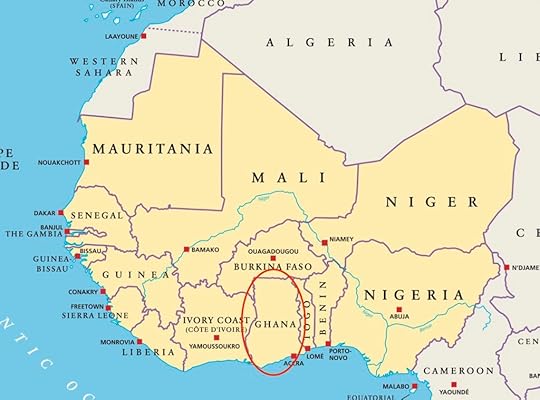
The World’s Female Sleuths: Ghana
Now, off to Japan, where in The Kingdom by Fuminori Nakamura, Yurika is a freelancer in the Tokyo underworld. She poses as a prostitute, carefully targeting potential johns, selecting powerful and high-profile men. When she is alone with them, she drugs them and takes incriminating photos to sell for blackmail purposes. This dark novel that pushes the boundaries of the genre with sympathetic antiheroine.
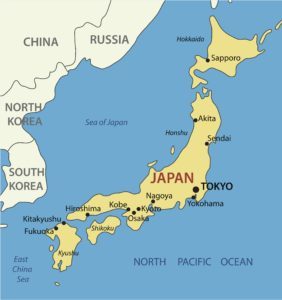
The World’s Female Sleuths: Japan (Shutterstock)

The Kingdom (Image: Soho Press)
Next, we zoom over to South Africa, where we find Jassy Mackenzie’s private investigator Jade de Jong. Library Journal says, “…For those readers who like Sara Paretsky and Lynda La Plante and fans of international crime fiction,” giving you an idea of how tough a protagonist she is.
Random Violence: In Johannesburg prosperous whites live in gated communities; when they exit their cars to open the gates, carjackings are common. But seldom is the victim killed, much less shot twice, like Annette Botha. Piet Botha, the husband of the wealthy woman, is the primary suspect in his wife’s murder. As Jade probes into this and other recent carjacking cases, a pattern begins to emerge, a pattern that goes back to her father’s murder and that involves a vast and intricate series of crimes for profit.
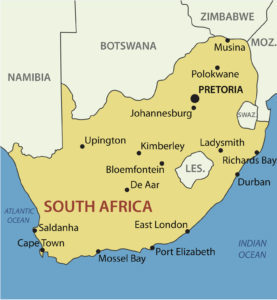
The World’s Female Sleuths: South Africa (Shutterstock)

Random Violence (Image: Soho Press)
Directly north of South Africa is Botswana, home to a female sleuth that to many will need no introduction: Scottish author Alexander McCall Smith’s creation, the dearly beloved Precious Ramotswe, who is revered for her pragmatic, gentle, but just view of the world.
The No. 1 Ladies’ Detective Agency, the first detective novel in the eponymous series, was first published in 1998. Mma Precious Ramotswe begins the first detective agency in Botswana in the capital city Gaborone, after her beloved father dies. She hires a secretary and solves cases for her clients. At first, Smith’s novels in this series didn’t catch on in the US, although it had a following in Smith’s native Scotland. It’s said that after September 11, 2001, mystery readers were looking for something comforting rather than violent and murderous, and this series really fit the bill. Today, these novels are seen everywhere in the world in multiple languages, a mere dream for most authors.

The World’s Female Sleuths: Botswana (Shutterstock)
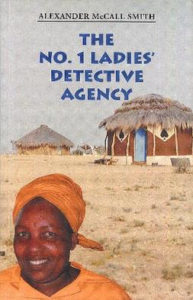
First edition of No. 1 Ladies’ Detective Agency (Fair use: http://bit.ly/Ramotswe)
Stay tuned for the next round of The World’s Female Sleuths. We’re not anywhere near done!
The post THE WORLD’S FEMALE SLEUTHS-1 appeared first on Kwei Quartey.
December 24, 2019
2020, YEAR OF THE WOMAN
YEAR OF THE WOMAN
To understand why 2020 will be the true Year Of The Woman, we must step back a little in time. By the end of 2017, I had completed my fifth Darko Dawson novel, Death By His Grace. In it, Darko’s new sidekick is a young female cop, Mabel Safo, who has been transferred to the Criminal Investigation Headquarters in Accra after she has been sexually assaulted by her commander. My original idea was to have Mabel continue with her own series while Darko was in the background or on a parallel track. However, in what would turn out to be a wise decision, my editor urged me to develop a brand new female protagonist quite separate from the Darko series. Thus, Emma Djan was born, making her debut appearance in The Missing American. I don’t believe it was by accident that I created a female detective. She was developing in my subconscious and being shaped by the events of 2017-2019, which have in turn set up 2020 to be the Year Of The Woman.
THE IMPORTANT WOMEN’S MOMENTS OF 2017-2019
Environmental Movements
Time magazine’s 2019 Person Of The Year is a diminutive but fierce Swedish teenage girl called Greta Thunberg. Beginning in August 2018, she made the world sit up and pay attention to climate change in a big way. In 2020 we hope for more international action in response to Greta, who has roundly chastised world leaders for doing little or nothing to ameliorate climate change.
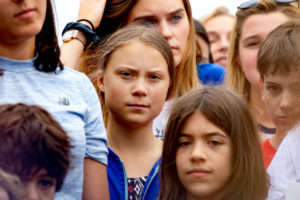
Year of the woman: The steely gaze of Greta Thunberg (Shutterstock/Aaron-Schwartz)
Power And Influence
In June 2018, Spain’s new Prime Minister Pedro Sánchez appointed a majority-female cabinet. Almost two-thirds of his cabinet-level appointees–11 of 17—are women.
In that same year, more than 100 women were voted into office in the U.S. House of Representatives. The Citadel, the Military College of South Carolina, announced Sarah Zorn as the first woman in its history to serve as regimental commander, the highest-ranking cadet officer, leading the 2,350-student corps. Meanwhile, New Orleans swore in LaToya Cantrell as the first female mayor in the city’s history; now, Louisiana’s three largest cities—Nola, Baton Rouge, and Shreveport—are all led by black women.
Stacey Cunningham put a chip in the glass ceiling over Wall Street when she became president of the New York Stock Exchange; with Cunningham’s promotion, and Adena Friedman as head of Nasdaq, both of the world’s largest stock exchanges are women-led for the first time.
Entertainment
Rachel Morrison, director of photography on 2017’s Mudbound, was the first woman to receive an Oscar nomination for Best Cinematography in 2018.
In 2018, Ava DuVernay, director of A Wrinkle in Time, joined the “$100 million club” of directors with films surpassing $100 million in earnings, and Jennifer Lee, the Oscar-winning screenwriter and codirector of Frozen, is named chief creative officer of Walt Disney Animation Studios.

Year of the woman: Ava Duvernay and Oprah Winfrey, two powerful women in entertainment (Kathy Hutchins/Shutterstock)
The Me Too Movement
For most of us, awareness of the Me Too (or #MeToo) movement began to dawn in 2017 when The New York Times (NYT) and The New Yorker first reported that dozens of women were accusing American film producer Harvey Weinstein, formerly of The Weinstein Company(TWC), of rape, sexual assault and sexual abuse over a period of at least thirty years. In fact, credit for the name Me Too goes to Tarana Burke, a black female activist and advocate who created the term more than 10 years ago in 2006 to remind women, in particular those of color, that they were not alone in their experiences of the sexual assault scourge.

Year of the woman: Tarana Burke (Lev Radin/Shutterstock)
On October 15, 2017, American actress Alyssa Milano, crediting Burke for the origins of Me Too, tweeted, “If all the women who have ever been sexually harassed or assaulted wrote ‘Me too.’ as a status, then we give people a sense of the magnitude of the problem.”
NYT reporters Jodi Kantor and Megan Twohey won the 2018 Pulitzer Prize for Public Service for exposing Harvey Weinstein’s decades of sexual harassment and assault in Hollywood. (The prizes are awarded by Dana Canedy, the first woman and first African-American to administer the prizes.) On January 1, 2018, as a crushing tsunami of sexual abuse allegations against Weinstein and many other powerful men broke the dam, Hollywood celebrities founded the Time’s Up movement against sexual harassment and gender inequality in the workplace.
One of the most horrific tales that came to light with Me Too was that of Larry Nassar, the former USA Gymnastics national team doctor and now-convicted serial offender who assaulted at least 250 young women and girls over a span of decades beginning in 1992. His victims included numerous Olympic and US women’s national gymnastics team members. Nassar confessed to ten of the accusations and on January 24, 2018, he was sentenced to 175 years in a Michigan state prison after pleading guilty to seven counts of sexual assault of minors.
Later, in September 2018, during a particularly cringeworthy congressional hearing, an anguished Christine Blasey Ford testified to allegations that Supreme Court nominee Brett Kavanaugh had sexually assaulted her in high school.
To end the tumultuous 2017-2018 year, it was fitting that Nadia Murad, a 25-year-old Yazidi woman abducted by ISIS in 2014, shared the 2018 Nobel Peace Prize for tireless work to end sexual violence.
FICTION IN THE ME TOO ERA
Cultural shifts are reflected not only in real life–news, articles, and non-fiction books–but also in fiction. Three recent novels, Milkman, by Anna Burns; His Favorites, by Kate Walbert; and Those Who Knew, by Idra Novey, have Me Too episodes within their pages. No doubt, there are other books that tackle sexual assault and there will be more to come. Fiction in the right hands–from Morrison to Atwood–can awaken us to ideas, experiences, and truths about which we heretofore knew little or nothing. Writers of fiction should be sensitive to cultural phenomena, which may play major or minor roles in their novels or contribute to the milieu of the work in subtle yet important ways.
From a personal standpoint, Me Too has brought into laser-sharp focus my already-existent awareness of just how pervasive men’s bad behavior is, and how women face men’s boorishness, unwanted advances, and sexual assault all day, everyday. Men–offenders and non-offenders alike–must face that fact and become sensitive to it.
I always considered myself a feminist, but Me Too anchored me. A seedling began to grow and blossom as I wrote The Missing American, in which Emma Djan first makes her appearance. Like Me Too, her time had come. Things happen when the time arrives. Five years ago, the Emma Djan of 2020 could probably not have been created, but she’s here now. I like Emma a lot. I find myself relaxed and soothed around her while in retrospect I realize I was tense and jumpy with Darko–perhaps the inherent male tendency to compete with another male–a remarkably prevalent characteristic across many animal species.
What is Emma like? She’s a regular churchgoer without being evangelistic. She’s a millennial but has made an old-fashioned decision to remain a virgin until marriage. Still, she isn’t a prude and certainly has a discerning eye for men. She’s wiry and rather thin, particularly as she skips meals often and fails to eat as much as she probably should. Many of Emma’s solid morals and determination come from her late father Emmanuel, who died tragically and prematurely of a stomach ulcer. He had been a detective, and as a little girl, Emma had watched him and learned from him as she strived to emulate him to the extent of becoming a detective as well.
As the Me Too movement progresses and becomes more mature in 2020, we welcome our new heroine Emma Djan as she arrives at the perfect moment very early in the Year Of The Woman.
The post 2020, YEAR OF THE WOMAN appeared first on Kwei Quartey.
November 22, 2019
THE CROWN: AFRICAN FACT VERSUS FICTION
The Crown: African fact versus fiction
As eager fans watch the Netflix third season of The Crown, Wikipedia “second-screen research” concerning historical aspects of British royalty has spiked. Viewers of the royal saga appear genuinely keen to compare weighty events in the show to what happened in reality. For example, already in the early episodes of Season 3, the horrific 1966 SouthWales Aberfan coal mining disaster has been portrayed. To its credit, The Crown highlighted this heartrending tragedy that relatively few remember or know about: A rain-sodden slag-pile slid into the village, killing 144 people including 116 children. After an 8-day delay, the Queen, played masterfully this season by Olivia Colman, finally visited Aberfan.
But returning to Season 2 of The Crown for a bit, one episode continues to draw comment: the November 1961 visit of Queen Elizabeth (Claire Foy) to Ghana during which she danced with then President Kwame Nkrumah (Danny Sapani) at a goodbye ball held in the Queen’s honor. Ghana had become independent from Britain in 1957 and Nkrumah, a visionary who had been imprisoned by the British colonials, brought that independence to fruition.
It’s unlikely that anyone would have paid the slightest attention to a relatively trivial occasion had The Crown not had a scene in which the Queen danced the foxtrot with Nkrumah. (As uncomfortable as it is to see, there’s quite a record of the royals dancing with indigenous people throughout the world.)
But in the court of African fact versus fiction, there are a number of reasons why the “dance episode” stirred some controversy. The show got some things right but a lot wrong. That’s television, I suppose. As The Crown correctly portrayed, trouble was in the air that 1961 year in Ghana, and some members of parliament and others recommended that she not fulfill a previously planned visit to Accra, Ghana’s capital. Nevertheless, the Queen insisted. At the time, Nkrumah was leaning toward socialist ideology. In the Cold War era, the specter of socialism in a leading African country such as Ghana was alarming to both the Americans and the British, who, after all, still possessed colonies in the 1960s. Losing Commonwealth countries to Russia was not an appetizing prospect. John Parker, a historian at the University of London’s School of Oriental and African Studies, said, “The British government was certainly concerned to limit Soviet influence in ex-colonies. Overseas tours by the queen were designed broadly to strengthen Commonwealth links.”
The dance didn’t magically snatch Nkrumah from the jaws of the communists back to the loving arms of the West and certainly was not a critical moment in the arc of Nkrumah’s political philosophy. He continued to adhere to socialism in subsequent years, even earning the Lenin Peace Prize the year after the queen’s visit. In an online NPR article, Tim McDonnell quotes Nat Nuno-Amarteifio, an architect and amateur historian who was mayor of Accra from 1994-98: “I still don’t know why that stupid dance is so important.”
I suspect Queen Elizabeth attached a lot less significance to the dance than The Crown suggests. In photographs and footage of the occasion, she seemed to be simply having a grand time away from stuffy old England dancing with Nkrumah while Prince Philip danced with Nkrumah’s wife, Madam Fathia. If the real Queen Elizabeth has ever watched The Crown and the Nkrumah episode in particular, she probably thinks it was much ado about nothing.
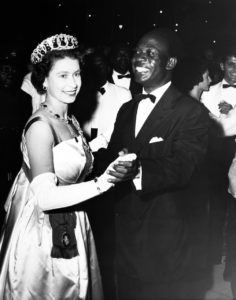
AFRICAN FACT v FICTION: Queen Elizabeth dances Highlife with President Nkrumah (AP Photo)
Other aspects of the show’s dance scene are cringeworthy. The depiction of an ecstatic Ghanaian press watching the dance is patronizing, and the overacted scenes in which supposedly bewildered British bureaucrats express horror that the Queen was “dancing with an African” are distasteful and hardly realistic. The implication of the The Crown‘s dance episode was that the Queen was playing Nkrumah. However, as Yepoka Yeebo points out in an excellent article, it might well have been the reverse. Nkrumah, adept at pitting the US and Britain against the Soviet Union (Nkrumah had met President Kennedy a mere 8 months before the Queen’s visit to Ghana), might well have been playing the Queen. Don’t forget, Nkrumah was the man who had wrestled his country out of the death grip of British colonials and was no stranger to political maneuvering. I surmise that he would not have tolerated “dancing with the oppressor” unless it made political sense.
Finally, let’s set the record straight: the Queen and the President did not do the foxtrot; it was Highlife, a time-honored musical genre of Ghanaian creation, specifically a piece composed, we’re told, specially for Queen Elizabeth’s visit. Nor did she and Nkrumah take the dance floor as a solo pair. They danced among a good crowd of other presumably important guests as shown by the footage below, courtesy of British Pathé. In the clip, notice the odd diction typical of both British and American newsreel narrators of the time.
Hopefully we can now put the topic of the dancing queen to merciful rest. And as for the accuracy of The Crown–well, as a fiction writer myself, I can’t get too self-righteous about it.
The post THE CROWN: AFRICAN FACT VERSUS FICTION appeared first on Kwei Quartey.
November 12, 2019
AFRICAN CRIME FICTION
AFRICAN CRIME FICTION
Magic and murder in African crime fiction
African crime fiction can offer more than its counterpart from elsewhere in the world by including supernatural phenomena in the plot, the murder, and the revelation of the killer. Wife Of The Gods introduces the reader to a custom in Ghana’s Volta Region, girls and young women are sent into the service of traditional (also called “fetish”) priests to atone for a wrong committed in the family—sometimes generations ago. The women are called Trokosi, or “wives of the gods.” In fact, tro means “deity,” and kosi means “slave,” a much more accurate representative than “wife.” The priest, who gets his/her name from the fetish objects kept for supernatural work, acts as an intermediary between the physical and spirit worlds. In return for the indentured servitude of these women, he is supposed to protect the family from catastrophe inflicted either by the ancestors, the gods, or an erstwhile curse.

AFRICAN CRIME FICTION: Ancient West African fetish object (Photo: Fabian Plock/Shutterstock)
The Trokosi custom is one example of the intersection of the tangible and supernatural in Ghana, where, unlike the West, these realms are not necessarily thought of as disconnected. If a hospital-dispensed medication is not working for someone who is physically ill, he or she may go to a traditional priest for a consultation and/or indigenous herbal treatment. The importance of curses, the ancestors, and the gods in African daily life cannot be overstated. The words juju, voodoo, and witchcraft are among those that describe how things occur in the physical world as a result of the supernatural.
Ghanaian investigative reporter Anas Aremeyaw Anas brought to light the little-known practice in northern Ghana of “spirit killings,” the murder of physically deformed children believed to be evil spirits. The exposure led to the banning of the practice by local chiefs. Westerners find it difficult to understand the interpretation of the physical world through the lens of the spiritual, or vice versa. How could a physical child be a “spirit?” Likewise, a witch is believed to have the ability to exert physical effects from an ethereal realm. They fly away from the physical body at night to join a coven of other witches, sometimes to eat a human victim. Hence a barren woman might be accused of being a witch who repeatedly consumes the baby trying to grow in her womb. But that isn’t literal. It occurs spiritually, and there again lies the difficulty of puzzling how the spiritual can occur in the physical world.
In the practice of sakawa in Ghana, supernatural abilities are granted to Internet swindlers via the powers of a fetish priest who makes the scammers perform certain bizarre tasks, such as obtaining body parts or fluids, especially sexually related, or having multiple episodes of sexual intercourse a day. “Sakawa boys” relate how these exercises and interactions with fetish priests radically increase their scamming skills, but also make their victim (called a mugu) more susceptible to being duped. For example, a fetish priest I met in Ghana showed me a chicken skull with a beak tied shut with string. After being buried in a cemetery, such an amulet will prevent the mugu from resisting the scammer’s demands, i.e. a tied beak can’t squawk and dead men don’t talk.
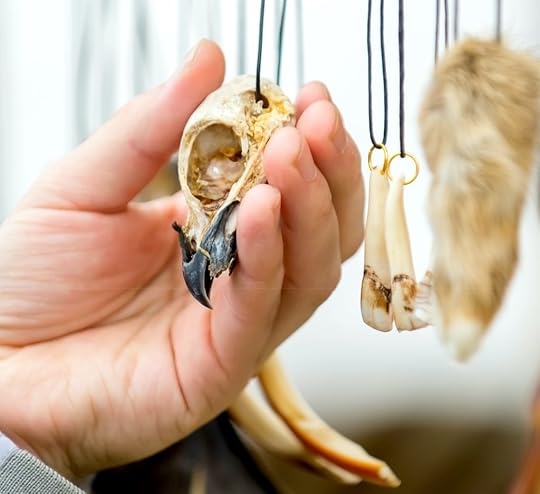
AFRICAN CRIME FICTION: Bird skull and beak as an amulet or talisman (Photo: Amtiko/Shutterstock)
An amulet is something you wear to ward off evil spirits, and a talisman is something that gives a person supernatural powers.
While supernatural phenomena in Ghana’s daily life serve as a unique background for much of the crime fiction I set in that West African country, it can also be a challenge. For logistic reasons too complex to go into now, my novels are not distributed to a significant degree in Africa in general and Ghana in particular. Western readers, primarily those in the United States, are and will remain my main market for the foreseeable future. So how do I introduce these unfamiliar beliefs and concepts like juju to my readers? Very carefully. It should appear seamless, which is not as simple as it may sound. Whenever I describe or highlight a supernatural phenomenon in my novel, I follow some general rules.
It should play an important part in the plot and not be tangential to the story.
I avoid making it seem gratuitous.
I avoid making it seem didactic.
I leave criticisms or praise of the custom to characters in the novel, not the narrator.
African Crime fiction v the reality
In real-world Ghana, crimes based in spiritual beliefs, murder included, may occur in secret or in remote locations in the country, e.g. rural areas with poor or difficult road access. What that means in practice is that they may exist under the radar of the almost universally under-resourced Ghana Police Service (GPS). In his paper, Appiahene-Gyamfi writes, “. . . some of the difficulties and shortcomings facing the GPS include the inability to cover all parts of Ghana, particularly the remotest countryside; inadequate and obsolete equipment[s] and accoutrements; poor data collection and record keeping; slow and sloppy investigations; and political influence.” Ironically, this reality is fodder for murder mysteries because it is a compelling background for a police detective or private investigator fighting for justice in a hamstrung, corrupt system that is, to boot, tangled up with spiritual beliefs.
Themes in African crime fiction
In an article called Post-Colonial Crime Fiction, Lindsey Green-Sims discusses West African crime fiction by citing seven different novels set in Ghana, Nigeria, Cameroon, and Liberia.
Tail Of The Bluebird by Nii Ayikwei Parkes, a murder mystery set in a contemporary Ghanaian village, blends CSI with magical realism. It might be described as an attempt to insert forensic science into the middle of a heavily traditional Ghanaian village where men and women “commune with the spirits of their ancestors.” This conflict between the modern and traditional is tailor made for fiction but reality-rooted.
In her article African Crime Fiction: The world as it is, or the world as we would like it to be? Karen Ferreira-Meyers, who notes the relative recency of the African crime novel, writes: “While the reader often chooses a crime novel for its entertainment value, these novels [by African authors] also communicate specialized knowledge, condensed and standardized from several of the many spheres of human activity that can sometimes come across as ‘exotic’ to Western readers.” For example, Achille Ngoye combines the usual depictions of crime with less familiar accounts of human sacrifice and witchcraft rituals in his novel Sorcellierie à bout portant (“witchcraft at close range”). Ferreira-Meyers also draws attention to the reflections of Abasse Ndione, who states, “occultism plays an essential role” not only during the course of the investigation, but also in solving the mystery, as is the case in his novel La vie en spirale.
Brutality and “readability”—where to draw the line in African crime fiction
One of the prerequisites of a ritual murder is that the victim be alive during the removal of his or her organs. The Screaming Of The Innocent by Unity Dow has a disturbing and graphic description of just such a murder of a 12-year-old girl in Botswana. The screaming of the victim is said to make the harvested flesh more potent when it is ultimately made into a medicine. The parts removed are often functionally related to the intended effect of the killing, for example, the Adam’s apple (the laryngeal prominence) to silence an opposing witness in court, or the breasts as a source of good “mother luck” that will bring good fortune as a potion. In my novels, I have used far milder descriptions of traditional “juju” ceremonies, but never a ritual murder. Although it is possible I might recount the aftermath of such a crime, a detailed account of the act itself is unlikely to appear in my stories, particularly if a child is involved. Every author has a “don’t-go-there” limit, and that is one of mine. Nevertheless, ritual murder as a phenomenon is a topic that needs to be faced if it is ever to be defeated. Crime fiction may never make it go away, but it’s a step in the right direction.
In summary, crime fiction out of Africa, a relatively new phenomenon, may contribute a new aspect to the genre, i.e. the part spiritual or mystical beliefs can play in crime, more specifically murder. Perhaps it’s time to add a new sub-genre category: African.
Allison & Busby
On a different but related note, excellent news that UK publishers Allison & Busby will be publishing The Missing American and the second in the Emma Djan series, Sleep Well, Dear Lady, which is on the editing block right now. Take a sneak peak at their exciting cover!

AFRICAN CRIME FICTION: UK edition of THE MISSING AMERICAN (Photo: network.bizz)
KJQ
11/8/19
The post AFRICAN CRIME FICTION appeared first on Kwei Quartey.
September 20, 2019
MISSING AMERICANS: The real ones
Missing Americans
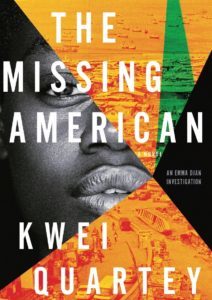
MISSING AMERICANS: The Missing American (Coming Jan 14, 2020)
THE MISSING AMERICAN, an Emma Djan Investigation in which Washington DC resident Gordon Tilson travels to Ghana and mysteriously disappears, is a work of fiction. But Americans going missing overseas is a reality played out far too often. So much so that there is a website called The Missing Americans Project.
Not that Americans are the only foreign nationals affected. In June 2019, the Ghana Police rescued two abducted Canadians who had been missing for a week. Kidnapping in Ghana is unusual (but could become more common) whereas in Nigeria, it is much better known primarily because of the ferocious actions of the fearsome Boko Haram, which targets Nigerian schoolgirls.
Of course, while we know that kidnappings of all kinds of people occur all over the world, it is stories of missing Americans in particular that tends get more attention in the US.
Missing Americans: Tourists
The disappearance and/or killing of Americans while abroad on vacation captures our attention because we think, “That could easily have been me.” Of late, the Dominican Republic (DR), has been in the news with bizarre deaths of Americans vacationing on the island, with suspicions of foul play in some cases.

MISSING AMERICANS: Grand Bahia Principe hotel where Moore and Ravenelle stayed (Shutterstock)
One case of missing Americans in DR that was not thought to be due to foul play was that of Orlando Moore and Portia Ravenelle. On March 27, 2019, the American couple, having been on a getaway for four days, disappeared in the DR after leaving the hotel to the airport in a rented vehicle to return to the US. They never checked in at the airport and their own car remained parked at Newark Airport. For two weeks, there was no word to the family until finally the Dominican authorities came forward. It’s believed Moore and Ravenelle were on their way to the airport for a 2 AM flight when something occurred, causing them to come off the freeway and into the Caribbean Sea. Ravenelle’s body was found unconscious and severely injured (on the side of a road by some reports), and she was taken to the hospital, where she died on April 4. The vehicle was recovered from the sea on April 13.
Missing Americans: Scientists
It’s disturbing to think that a scientist, so dedicated to his or her profession, can travel overseas to share and learn in a noble field and end up missing or dead. In July 2019, scientist Suzanne Eaton, was in Chania on the Mediterranean island of Crete for a scientific conference. Believed to have gone for a run near her hotel, she vanished on July 2 and wasn’t seen for two weeks. Six miles from her hotel, she was found dead by two local men exploring a network of tunnels in an abandoned bunker carved out of the rock by the Nazis troops during WW II. Cave networks are well known in Crete.

MISSING AMERICANS: Exploring a cave in Chania, Crete (Shutterstock)
Forensic evidence on Eaton’s remains showed she had fought hard against a knife-wielding attacker. She was a strong athlete and an avid runner with a black belt in Tae Kwon Do, so you know she did not go quietly! She used all the fight she could muster from her training. On the other hand, the police believed her killer was also physically very strong, and evidently in the end overpowered her.
Missing Americans: Missionaries
Like scientists, missionaries believe firmly in their cause, even though their respective approaches to “truths” differ. In November 2018, John Allen Chau went on a mission to the remote Indian North Sentinel Island to “declare Jesus” to the isolated tribes there. These tribespeople hail from 30,000 years ago and should not be messed with. They resist any contact from outsiders and if you come into their territory, you will likely never leave alive. Chau made three attempts to mingle with the people on this island he called “Satan’s last stronghold”. Two other Christians with a canoe helped him go ashore on each attempt. The response from the islanders was clearly hostile, but Chau preached to the tribespeople and tried to explain to them that Jesus loved them. On his third attempt to make contact, he was struck by a volley of arrows unleashed by the Sentinelese. He died there.

MISSING AMERICANS: Aircraft photo of North Sentinel Island (Shutterstock)
Missing Americans: what to do when you travel
One misconception is that the United States government and the FBI can intervene in some way in a sovereign country when an American goes missing in that country. While American embassies state they are dedicated “to protect[ing] the lives and interests of U.S. citizens., there is often not much they can do if a crime has been perpetrated against an American, or if an American has committed a crime in a host country. Most embassies must depend on the abilities of the local police, whose levels of sophistication vary wildly depending on the part of the world.
Even “Legats,” short for legal attachés, cannot intervene in the affairs of the sovereign country unless specifically requested or if the situation directly affects the security of the United States. Lots of variability exists in this regard. As the Missing Americans Project states, “. . . the absence of clear standard operating procedures within and among U.S. embassies and a lack of State Department support leads to an unconscionable waste of time when time is of the essence.” In the novel The Missing American, Derek Tilson finds this out the hard way as he tries to find his missing father.
Before traveling to another country, check for any travel advisories by going to Travel.State.Gov and entering your destination under “Learn about your destination.” I would take any advisories about your destination quite seriously. The website will also provide emergency numbers for the embassies or consulates in that country, which can be used both inside and outside the country.
Go places only with people you know and trust. Don’t accept rides from people who say they drive you somewhere unless you have summoned that person yourself, i.e. Uber or whatever ride service might be available at your destination. Be careful where you go at night. In some countries, long- and medium-distance travel can be hazardous and could get you ambushed and robbed. Just be sensible, and you’ll be okay. Above all, avoid isolated tribes on remote islands.
The post MISSING AMERICANS: The real ones appeared first on Kwei Quartey.
August 3, 2019
WHO IS GORDON TILSON?
Gordon Tilson is an important character in the novel The Missing American, which will be released on January 14, 2020.
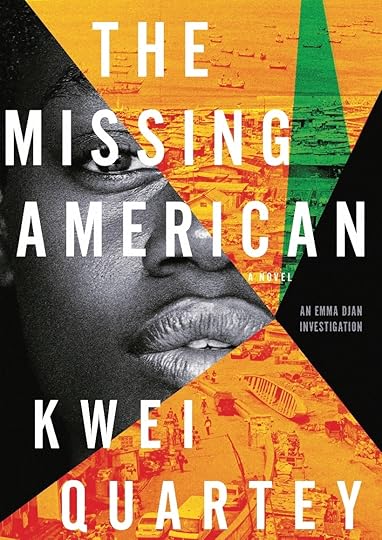
Who is Gordon Tilson? The Missing American (Coming Jan 14, 2020)
Gordon Tilson grew up in Washington, DC. In his early 20s he joined the Peace Corps, a government program established through an executive order issued by issued by President John F. Kennedy on March 1, 1961. Its official mission is to provide social and economic development abroad through technical assistance, while promoting mutual understanding between Americans and populations served.
For his service, Gordon went to Ghana, which was the first country in the world to receive Peace Corps workers. While in Ghana, Gordon fell in love with Regina, a Ghanaian woman. They married and after returning to the United States, had their first and only child, Derek.
The couple’s married bliss ended in tragedy when Regina fell victim to ovarian cancer, leaving Gordon a devastated widower. In the fourteen years that followed, he was a lonely man, but things changed one day when a Ghanaian widow reached out to Gordon on Facebook, thus beginning his second love affair with a Ghanaian woman. Feelings became so intense that G0rdon decided he wanted to meet Regina. He flew from DC to Accra
His eagerness to finally see her in person was crushed when she did not show up to the airport to meet her. Neither could Gordon subsequently by phone. Weeks later, he went missing, leaving a tantalizing trail of the places he had visited and left his mark, so to speak. And then the trail abruptly ended.
On the night of April 3rd, something bizarre happened on the Adome Bridge, Ghana’s equivalent to the Golden Gate. The question is, what? and what did it have to do with Gordon, if anything?
The post WHO IS GORDON TILSON? appeared first on Kwei Quartey.
July 26, 2019
LETTER FROM GHANA–1
Letter from Ghana
I’ve been in Ghana now for just under a month combining books/family/leisure, although I have to say I’ve had little of the latter. A plan to travel to a well-known monkey sanctuary in the Volta Region this weekend got nixed by some business that came up.
Some of the locales and experienced echo events in my upcoming novel THE MISSING AMERICAN (TMA) for example, the first-time arrival of one of the main characters into the new Terminal 3 at the Kotoka International Airport in Ghana’s capital, Accra. It was my first as well.
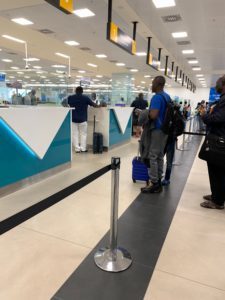
Letter from Ghana: Customs, T3, Kotoka International Airport (photo: Kwei Quartey)

Letter from Ghana: The Missing American (Coming Jan 14, 2020)
Affairs concerning books have been active! Not long after my arrival I visited the Vidya Bookstore in Accra, which has been carrying some of my novels on a limited basis. The impediment, bookstore owner Heena (below) explained to me, is the expense of shipping books from the US. The costs from the UK are considerably less steep.
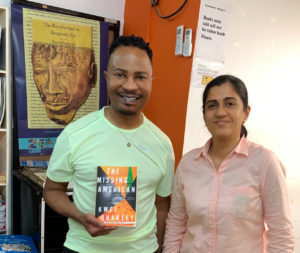
Letter from Ghana: At Vidya Bookstore with owner Heena Karamchandani
Last week I was on a Citi FM radio program hosted by Writers Project of Ghana (WPG), reading from and discussing TMA along with brilliant young Nigerian Nnamdi Oguike, author of Do Not Say It’s Not Your Country.

Letter from Ghana: In the green room at Citi FM before the WPG show
WPG also organizes readings at Jamestown Cafe, a place I’ve never been but which sounds fascinating. I’ll be reading from TMA there as well on August 3rd, a few days before I leave Ghana and head to a completely different environment: Sweden!
The post LETTER FROM GHANA–1 appeared first on Kwei Quartey.
June 30, 2019
THE MISSING AMERICAN
The Missing American
When American Gordon Tilson joined the Peace Corps in the 1980s, he went to the country of Ghana for his service. There, he met and fell in love with Regina, a Ghanaian woman who became his wife. Regina gave birth to their only child, Derek, after the couple returned together to Washington, DC.
Gordon and Regina truly loved each other. Regina established herself within a circle of influential Ghanaians in the DC area, particularly the diplomatic set. Gordon willingly tagged along with her to various parties and official events. Essentially, he was happy so long as Regina was happy.
After decades of Gordon and his wife being together, their happiness was snatched away as Regina developed ovarian cancer and subsequently died of the disease, which typically has a dismal prognosis. Gordon, now a widower, was devastated. He felt as if a part of him had been chopped out and he couldn’t imagine going on without his beloved.
But, as much as he doubted he would, he survived and came to terms with the death of his wife after a long, difficult period of adjustment. In many ways, Derek, now a young adult, was his rock. Gordon became a kind of unofficial counselor for others going through the loss of a spouse, joining a Facebook group called Widows & Widowers, where he helped ease the pain of other members seeking solace. Nevertheless, that Derek was lonesome is undeniable. The void created by Regina’s absence had never really been filled. As he grew older, that feeling of emptiness intensified rather than ameliorating.

The Missing American: Accra’s growing skyline (Photo: Yaw Ansong/Wikipedia)
The timing seemed perfect then, when Helena, a beautiful Ghanaian woman in Accra, reached out to Gordon on the Widows & Widowers page. He would always remember the day well, because it was two days before Thanksgiving Day that he met Helena online. She too, had lost her spouse years prior. She seemed quite taken with Gordon, and he her. The online communication progressed until they were Skyping and WhatsApping regularly. Gordon’s feelings for Helena deepened by the day.
Then, disaster struck. Helena’s sister Stella was maimed badly in an auto crash, which can be particularly lethal in Ghana. Medical care, particularly intensive care, is not free in Ghana. If you can’t pay, you may not survive an illness. Unable to fund Stella’s stay in the ICU, Helena faced the possibility that her sister might die.
There was no way Gordon, on hearing this news, could simply stand by and let this happen, so he sent Helena money to pay for medical expenses to the tune of about $4000. Stella pulled through, and Gordon was instrumental in turning around a potential tragedy. Helena owed him a debt of gratitude.
This event served to strengthen Gordon’s and Helena’s bond, and eventually Gordon decided, in fierce opposition to Derek’s advice to the contrary, that he just had to visit Ghana, once again, to meet Helena. Imagine his excitement on the morning he landed at Accra’s airport, complete with its brand new Terminal 3. His anticipation was not to be rewarded, however. Gordon never did meet the woman he envisaged as the new love of his life. In fact, things went from bad to worse. Gordon never returned to Washington, DC. Back at home, Derek lost contact with his dad. As the weeks passed, it became clear that Gordon Tilson had now become the missing American in Ghana. What did happen to him? The book, The Missing American has the answers.

The Missing American (Coming Jan 14 2020)
The Missing American, introducing the first Ghanaian female private investigator in fiction, will be released January 14, 2020. It’s available for pre-order from all locations online and at your neighborhood brick-and-mortar store.
The post THE MISSING AMERICAN appeared first on Kwei Quartey.
May 9, 2019
AFRICAN FICTION, WESTERN READERS
AFRICAN FICTION, WESTERN READERS
African fiction, western readers? Why is that a question?
The sad irony of African writers in the diaspora is that much of their work may never be read in the countries where the stories are set. That’s because, ultimately, the fiction is geared to a largely western markets. That means African writers must tell a story that the presumably mostly western audience will understand.
Africa is rich with custom and tradition, and it varies from country to country (there are 54 in total). Many of these cultures are baffling or illogical to the western reader. In an interview with Rudolf Okonkwo, Nigerian author Chibundu Onuzo relates how when she was writing her novel, The Spider King’s Daughter, her editors were sometimes unable to understand the Nigerian Pidgin the author had portrayed in sections of the book. She made some changes as a compromise, but she was less willing to do the same thing in her second novel, Welcome To Lagos, and indeed on occasion said, in effect, “Sorry you don’t get it, but I’m not changing a word.”
With my novels set in Ghana, West Africa, I understand the thin line African writers in the diaspora often have to walk between authenticity of the language and customs of the setting and “selling out” to western sensibilities and levels of understanding. Sometimes it’s a teeter-totter situation with authenticity gaining the upper hand over readers’ comprehension and vice versa, but it doesn’t have to be. There’s usually a “sweet spot” somewhere in between. The devil is in the details.
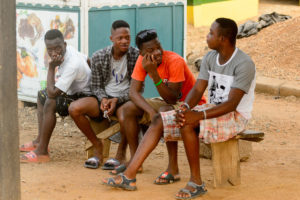
AFRICAN FICTION, WESTERN READERS: Young Ghanaian men having a discussion (Shutterstock/Anton Ivanof)
Language
In African fiction for western readers, language may be difficult to represent. I include a full glossary in all my novels set in Ghana, not only to translate phrases or words in one of the indigenous languages (not “dialects”), but also to explain slang terms. For example “Chale” or “chaley” (chah-LAY) means “bro” or “dude.” Funnily enough, “bro” has now entered Ghanaian slang.
Young Ghanaian men like those shown conversing in the photo above are likely to speak in their indigenous tongue, Ghanaian pidgin, or a mixture of both. Here’s a passage from my upcoming novel, THE MISSING AMERICAN (about which I’ll tell you in my next blog.) In this section, one young man is explaining how to defraud an unsuspecting victim online:
“When I call the man on Skype, what he go see is some fine woman smiling at him. I tell him say my computer microphone no dey work well, so make we type instead.”
In context, this is not too difficult to understand, but it’s probably watered down from what it could be in reality. I admit I am not an expert Ghanaian pidgin English speaker nor do I pretend to be. Nigerian Pidgin can be even more advanced and may interject fewer words from indigenous Nigerian languages than Ghanaian pidgin does. It should be said that pidgin is not necessarily a reflection of educational status. Well-educated Ghanaians use it as well and it appears to go along with a certain “hipster” or “cool” affectation. Males seem more predisposed to pidgin, at least in Ghana.
Customs
When writing African fiction for western readers, some customs unique to the particular locale might seem odd to the reader. Sometimes it can be presented as an explanation by the writer, or alternatively can be seen through the eyes of an observer. For example, rather than my writing, “They shook hands with the guests from right to left, as is the accepted custom,” the reader can experience it through a character’s eyes. This works especially well if the character is foreign to the culture, i.e. “John noticed how they shook the guests’ hands strictly from right to left, and made a mental note to do the same.” Or John could ask someone in the know, “Do you always have to shake hands from right to left?” This way, the character and the reader are learning something new at the same time.
Another example from Ghana is that eating, giving and receiving must always be done with the right hand, the left hand traditionally regarded as the “toilet” hand. I confess I once handed some money to a Ghanaian with my left hand and felt highly embarrassed when I realized my faux pas. And not as if I didn’t know this. I just forgot! 






